Moving to a new home comes with many exciting opportunities and fresh starts. But, moving also means packing up everything you own, which can feel overwhelming. Thankfully, going into your move with tips for packing and moving can ease your stress, making the process seamless and keeping your focus on the excitement of your new home. So, how to pack for a move? At Stewart Moving & Storage, we are here to help calm your worries with thorough moving company packing tips that can keep you on track for your upcoming move.
> Read more moving tips:
Pre-Move Preparation
Effective pre-move preparation is the cornerstone of a successful and stress-free relocation. These initial moving tips for packing will set you up for a smoother transition to your new home. Consider these packing tips for moving as your foundational checklist.
Start Sourcing Boxes
One of the first packing tips moving enthusiasts will tell you is to start gathering boxes early. You'll need a variety of sizes – small boxes for heavy items like books, medium boxes for general household goods, and large boxes for lighter, bulkier items such as linens and pillows. Check with local grocery stores, liquor stores, or online marketplaces for free or discounted boxes. Don't forget specialty boxes, like wardrobe boxes for clothing or dish packs for fragile kitchenware.
Learn more:
How to Move a Grandfather Clock Safely in 9 Simple Steps
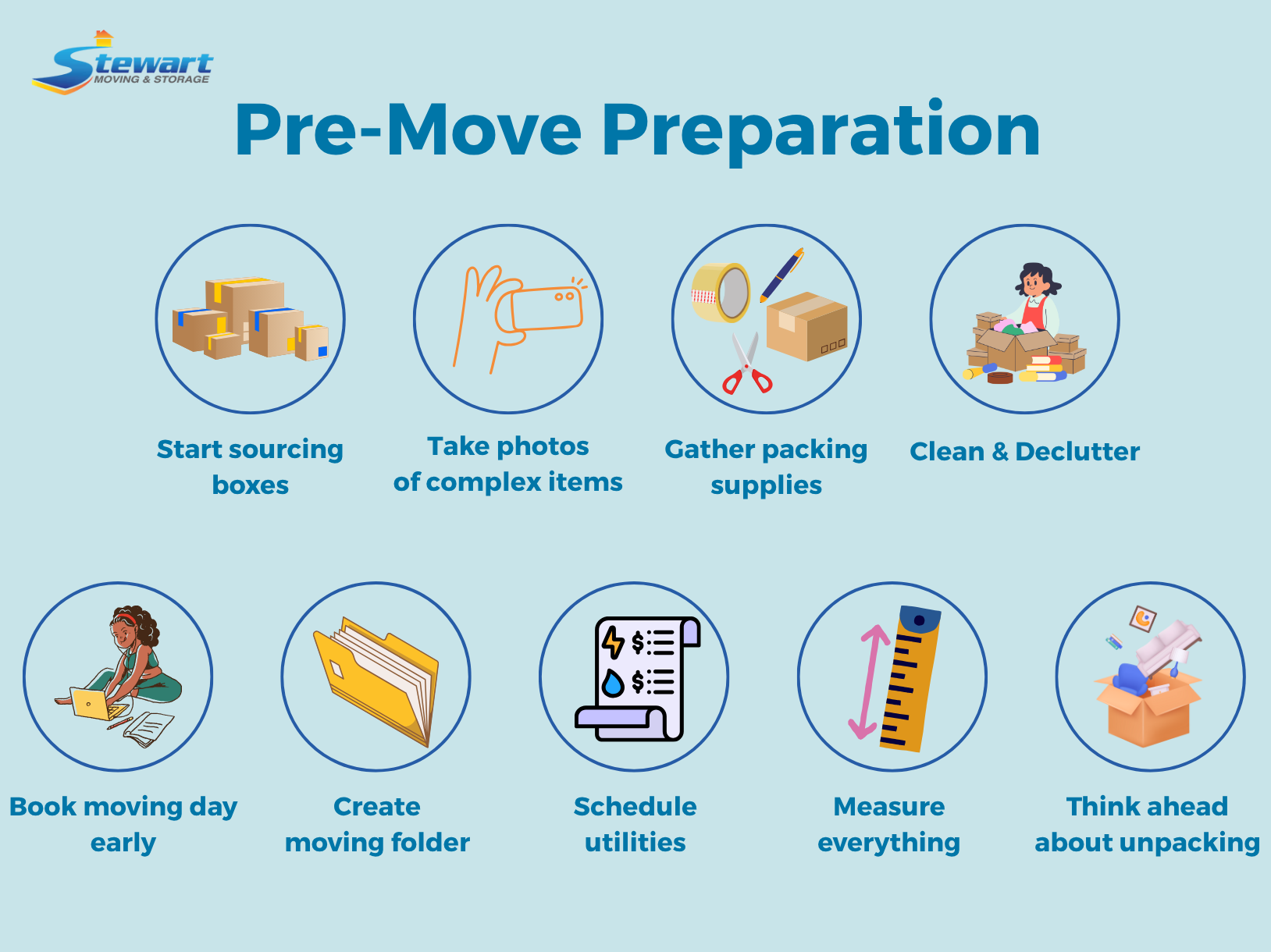
Take Photos of Your Complex Items
Before you start disassembling furniture or unplugging electronics, take photos. This is a crucial step in our tips for packing and moving complex setups. Documenting how your entertainment center is wired or how that intricate shelving unit is assembled will be invaluable when you're setting things up in your new home. This is one of the smartest packing tips for moving that often gets overlooked. Plus, you may want to look back on photos of your old home someday.
Gather and Organize Packing Supplies and Items for Moving
Beyond boxes, you'll need a range of packing supplies. Essential packing tips for moving always includes having plenty of strong packing tape, bubble wrap, packing paper (plain newsprint works well and is cheaper than printed), and permanent markers for labeling. Also gather scissors, a utility knife, and perhaps some colored tape or stickers for a color-coded labeling system. Having all your supplies in one designated area before you begin packing will streamline the process. Many moving company packing tips also suggest creating a small toolkit with essentials like screwdrivers, pliers, and an Allen wrench set for disassembling and reassembling furniture.
Learn more packing tips:
Moving an Aquarium: How to Pack and Move a Fish Tank
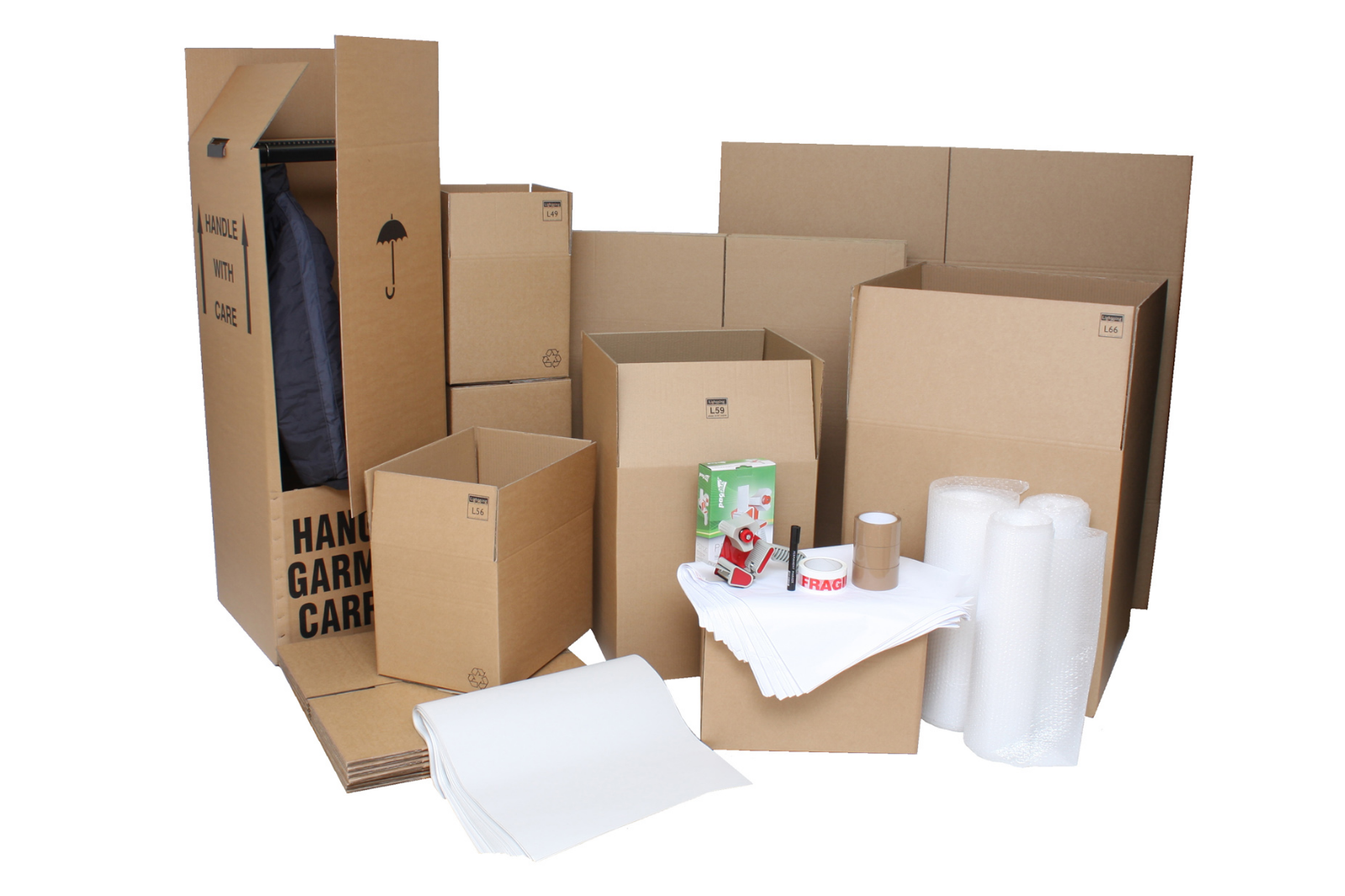
Prepare for Your New Home by Cleaning & Decluttering
Moving is the perfect opportunity to declutter. Before you pack a single item, go through each room and decide what you truly need to take with you. This is one of the most effective tips for packing and moving to reduce the volume of items you're transporting, which can save you money and effort. Donate, sell, or discard items you no longer use, want, or need. Simultaneously, if possible, arrange for your new home to be cleaned before you move in. Arriving at a fresh, clean space makes the unpacking process much more pleasant. This proactive approach is a key element of smart packing tips for moving.
Book Your Moving Day Early
Securing your moving date with a reputable moving company should be high on your pre-move checklist, especially if you're moving during peak season (summer months, end of the month). Get quotes from multiple movers, check reviews, and confirm their insurance and licensing. Once you've chosen a company, book your date as far in advance as possible. This is a critical part of packing tips for moving that ensures you have professional help lined up.
Learn more: A List of Things We Can’t Move and Why.
Create a Moving Folder
Keep all your move-related documents in one easily accessible place. This moving folder or binder should contain your moving company contract, estimates, inventory lists, receipts, contact information, and any other important paperwork. This is one of the simplest yet most effective packing tips moving experts recommend for staying organized. Having everything consolidated will be a lifesaver if you need to reference any information quickly during the chaos of the move. These tips for packing and moving help maintain order.
Schedule Utilities for Your New Home
Ensure a smooth transition by scheduling the transfer or setup of utilities at your new address in advance. This includes electricity, gas, water, internet, cable, and trash service. Coordinate the shut-off date for your old home and the start-up date for your new one to avoid any service interruptions. This is an essential part of packing tips for moving that ensures your new home is comfortable and functional from day one. Don't forget to also submit a change of address form with the post office.
Learn more: How to Pack a TV for Moving Safely | TV Shipping Guide
Measure Everything
Before moving large furniture, measure doorways, hallways, and staircases in both your old and new homes. Also, measure the dimensions of your large items. This crucial step will help you determine if your oversized sofa or antique armoire will fit through tight spaces, potentially saving you from damage or the need for last-minute disassembly. Knowing these measurements can also help you plan furniture placement in your new home. These tips for packing and moving prevent costly surprises.
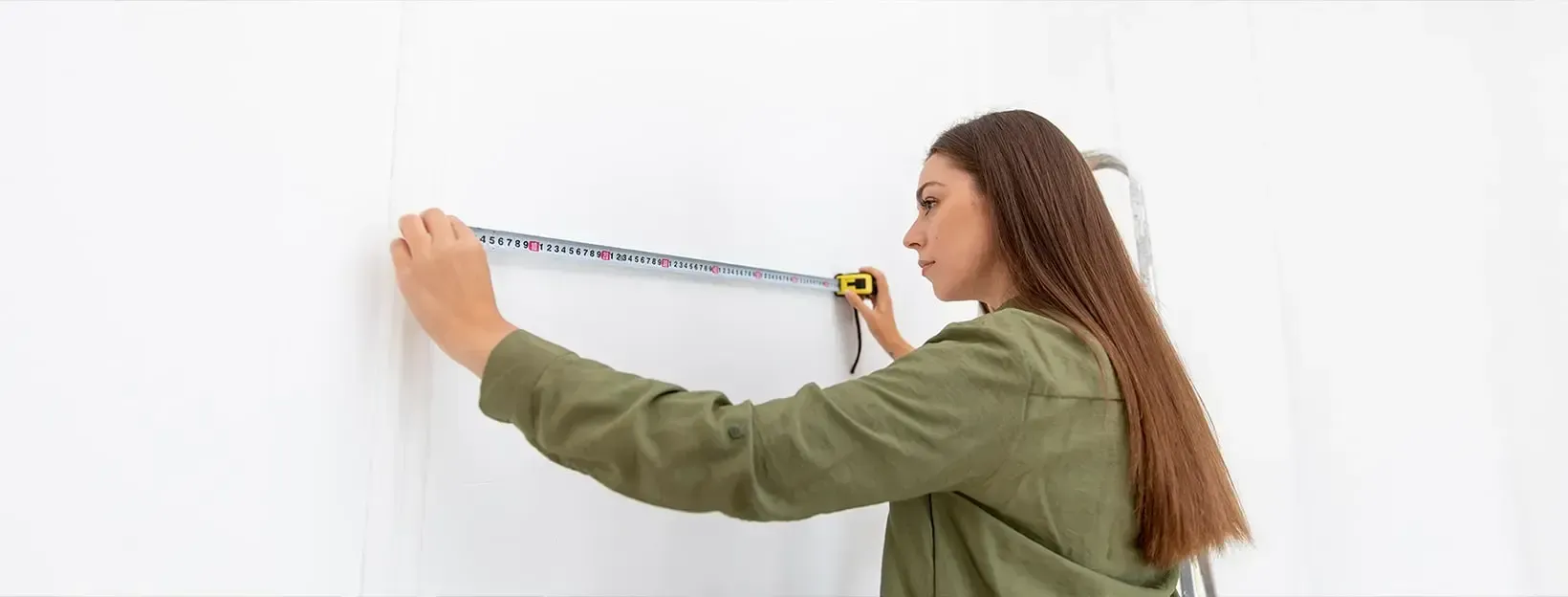
Think Ahead About Unpacking
While you're still in the packing phase, think about how you'll unpack. This foresight is a valuable part of packing tips for moving. Label boxes not just with their contents and destination room, but also with a priority level (e.g., "Open First," "Essentials," "Low Priority"). This will help you tackle the most important items first when you arrive at your new home, making the settling-in process more organized and less overwhelming.
Learn more: How Much Does It Cost On Average To Move A House (3 Bedroom)
Essential Packing Supplies
Having the right packing supplies on hand is fundamental to efficient and safe packing. Before you begin, gather everything you’ll need to avoid interruptions. Key supplies include sturdy boxes in various sizes (small, medium, large, and specialty ones like wardrobe boxes and dish packs), strong packing tape (invest in quality tape to prevent boxes from bursting open), bubble wrap for cushioning fragile items, packing paper (plain newsprint is ideal as it’s ink-free and affordable) or foam pouches for wrapping delicate belongings, and permanent markers for clear labeling. Don’t forget tools like a box cutter or utility knife, scissors, and a tape dispenser. Some tips for packing and moving also suggest using furniture blankets or pads for protecting larger items, and stretch wrap to secure drawers or keep items bundled. Having these moving essentials ready will make the entire process smoother and more organized.
Learn more about our moving services:
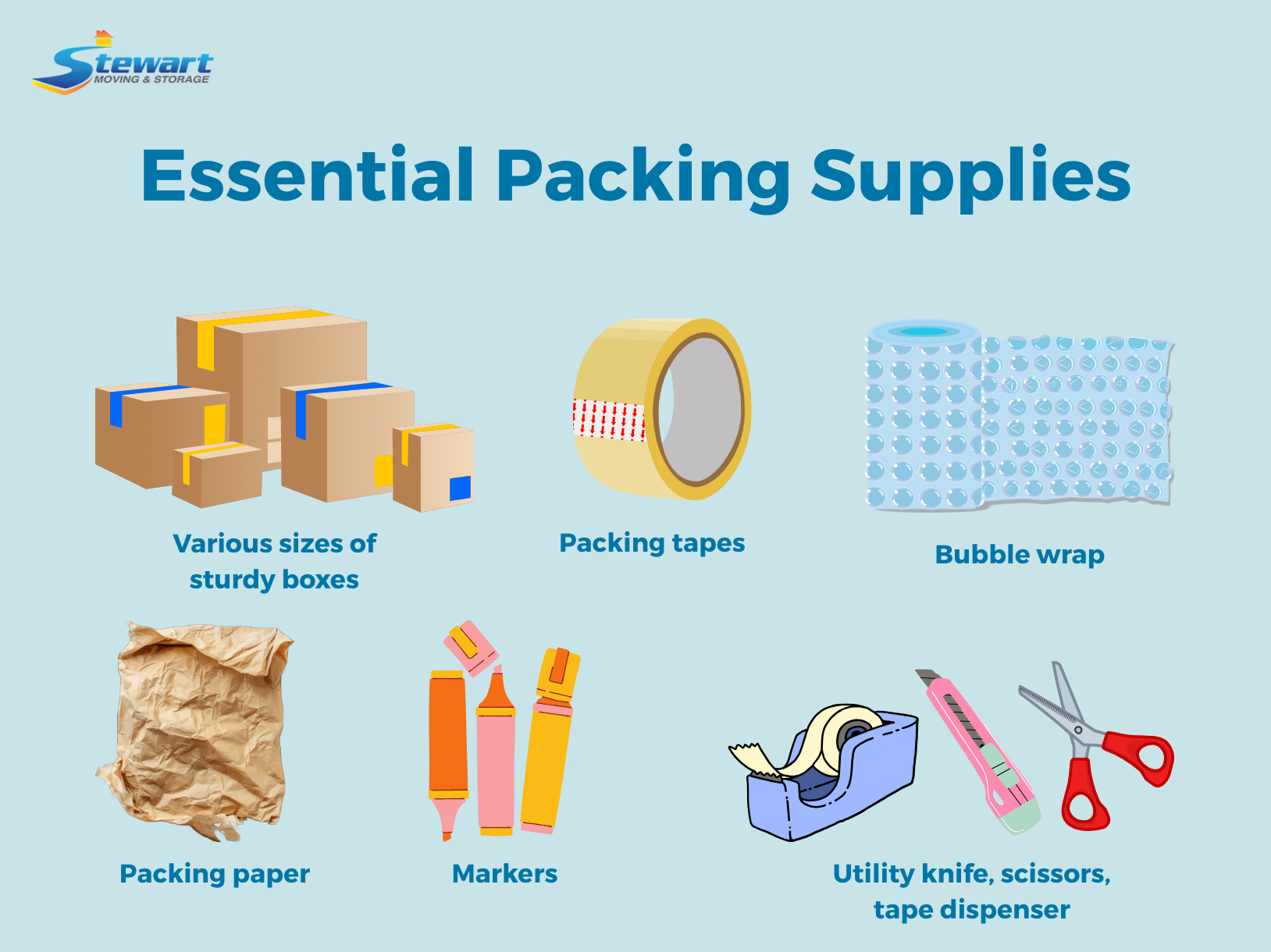
How to Pack for Moving: Packing Strategies
Get Rid of Unnecessary Items
One of the most impactful packing tips for moving is to declutter before you pack. As you begin the moving process and sort through your belongings, you’ll inevitably find items you no longer need, use, or love. Don’t waste time, space, and energy moving these unwanted items to your new home. Create a designated “donation” pile, a “sell” pile, and a “discard” pile. The key is to be ruthless; if an item hasn’t been used in a year, or doesn’t fit your new lifestyle, it’s probably time to let it go. This is one of the best tips for packing and moving to save on moving costs and make unpacking easier.
Use Appropriately Sized Boxes
Effective packing tips for moving always emphasize the importance of selecting the right boxes. Do not overpack or underpack your moving boxes, as both can lead to damage. A crucial piece of moving company packing tips is to use a variety of box sizes. Generally, pack heavier items like books, tools, or canned goods in smaller boxes to keep them manageable. Lighter, bulkier items such as linens, pillows, and lampshades can go into larger boxes. Limit the weight of any single box to a maximum of 50 pounds to make handling easier for both you and your movers. Wrap items carefully and provide plenty of cushioning, like packing paper or bubble wrap, to absorb shock and prevent items from shifting during transit.
Learn more: Storage Moving Guide
Label Fragile Boxes for Careful Handling and Use Care when Packing
Properly handling and labeling fragile items is a critical aspect of our packing tips for moving. When packing delicate belongings, always err on the side of caution. Wrap each fragile item individually in clean packing paper. For extremely delicate items like fine china, crystal, and figurines, use softer materials such as tissue paper, paper towels, or even facial tissue for an initial layer of protection before wrapping with paper or bubble wrap. Some moving company packing tips suggest using colored wrapping paper or colored tissue for very small, delicate items; this makes them more visible and less likely to be accidentally discarded with packing materials during unpacking. Use a double layer of newspaper or packing paper to create a good buffer at the bottom and top of boxes containing fragile items. After wrapping these items carefully, place them in sturdy boxes that are not overpacked – avoid cramming items together. Fill any empty spaces with packing peanuts, bubble wrap, or soft linens to prevent shifting. Most importantly, clearly label these boxes on all sides with “FRAGILE,” “HANDLE WITH CARE,” and “THIS SIDE UP” using a bold, permanent marker. This ensures that anyone handling the box, including your movers, is aware of its delicate contents and uses appropriate caution. These tips for packing and moving fragile goods are essential to prevent breakage.
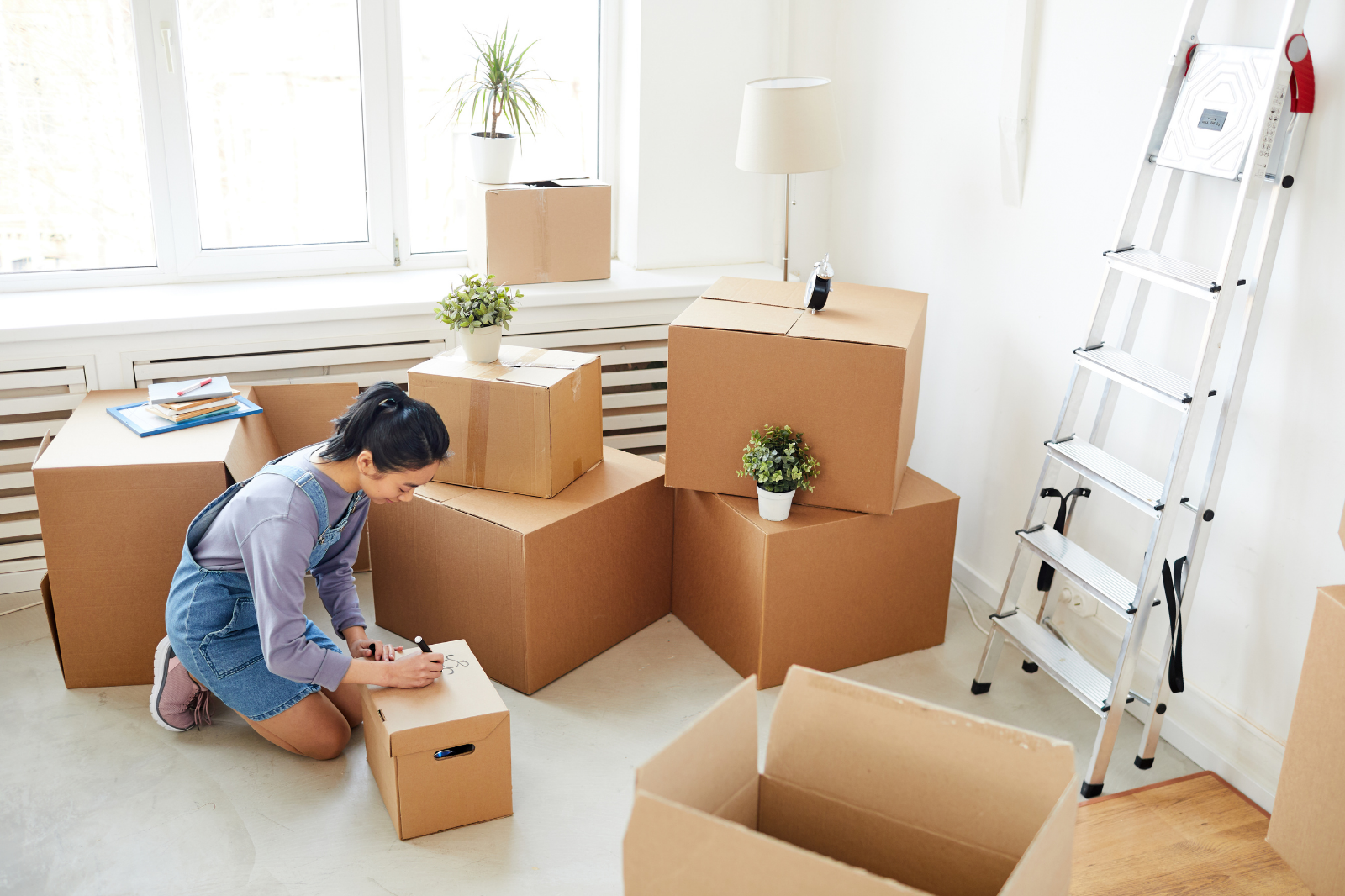
Carefully Tape Your Moving Boxes
Securing your moving boxes properly is a fundamental step in our moving packing tips, and it starts with good quality tape. Invest in high-quality packing tape (pressure-sensitive plastic tape or water-activated paper tape are good choices) to make sure your boxes do not suddenly fall open during transit, leaving your items strewn on the ground or damaged. Avoid using masking tape or cellophane tape, as they are not strong enough for sealing moving boxes. When applying the tape, ensure you carefully line all seams of the box. For standard slotted cartons, this means taping down the center seam where the two top flaps meet, and then taping along the two edge seams. A highly recommended technique in tips for packing and moving is to make an “H-pattern” with the tape on both the top and bottom of the box. This involves taping along all seams where the flaps meet and across the main seam, forming the letter 'H'. This method adds significant strength and ensures the box remains sealed.
Pack Room by Room
To maintain organization and efficiency during your move, one of the most effective packing tips for moving is to tackle one room at a time. Avoid a sporadic approach where you jump between rooms, as this can lead to confusion and misplaced items. Focus your efforts on completely packing one room before moving to the next. Pack similar items together. For instance, keep all your kitchen gadgets in boxes designated for the kitchen, and all your office supplies in boxes for the office. A crucial piece of our moving company packing tips is to avoid mixing items from different rooms in the same box, as this will complicate the unpacking process significantly. Be mindful of item compatibility; for example, do not pack a delicate china figurine in the same carton with heavy cast-iron frying pans, even if they are from the same room. Keep all parts or pairs of things together. For example, curtain rod hangers, mirror bolts, remote controls, and other small hardware items should be placed in clear plastic bags or small, labeled cloth bags and, if possible, taped securely to the item they belong to or packed in the same box with a clear label. If you hire a professional moving service, they may provide specialty bags or small boxes for such items as part of their service. This room-by-room packing method will make unpacking and settling into your new home much more systematic and less overwhelming.
Learn more about our moving service: Long Distance Movers | Reliable and Expedited Moving Company
Place Heavier Items at the Bottom of Boxes, Lighter Items on Top
A fundamental rule for safe and effective packing, often emphasized in moving company packing tips, is to always place heavier items at the bottom of your moving boxes and lighter items on top. Once the heavier items create a stable base, you can then add medium-weight items, followed by the lightest items at the very top. This distribution of weight prevents lighter, more delicate items from being crushed by heavier ones during transit. It also helps to maintain the structural integrity of the box and reduces the risk of it tipping over or becoming unbalanced. This is one of the most practical packing tips for moving that ensures both the safety of your goods and the ease of handling for anyone lifting the boxes.
Use Suitcases or Bags for Packing Heavy Items
Don't overlook the utility of your existing luggage when packing for a move. This is a clever piece of packing tips and moving advice that can save you boxes and make transporting certain items easier. Suitcases, duffel bags, and even sturdy reusable shopping bags can be excellent for packing heavy, non-fragile items like books, tools, or collections of DVDs or video games. The wheels on suitcases make them particularly useful for moving very heavy loads without straining your back. This is one of the most economical tips for packing and moving that leverages items you already own. When using bags, ensure they are strong enough to handle the weight and won't rip.
Avoid Empty Spaces in Boxes
A common mistake that leads to damaged goods is leaving empty spaces in moving boxes. Empty spaces allow items to shift, knock against each other, and potentially break during transit. To prevent this, one of the most important packing tips for moving is to fill all voids. To avoid awkward spacing and ensure a snug fit, use cushioning materials like bubble wrap, packing paper (crumpled newsprint works well), packing peanuts, or even soft household items like towels, blankets, or clothing to fill in any excess space within the boxes. The goal is to pack items tightly enough that they don’t move when you gently shake the box, but not so tightly that they are under pressure. Making sure each box is compactly packed and stabilized ensures that your items stay safe and secure throughout the journey. These tips for packing and moving help minimize the risk of damage.
Prepare a First Night Box
One of the most thoughtful packing tips moving experts always recommend is preparing a “first night box” or an “essentials box.” After a long day of moving, the last thing you’ll want to do is rummage through dozens of boxes searching for basic necessities. Set yourself up for success and a less stressful first night in your new home by packing this box with items you'll need immediately upon arrival and for the first 24 hours. Your first night box should include essentials like toiletries (soap, toothbrushes, toothpaste, toilet paper), any necessary medications, a change of clothes and pajamas for everyone in the family, basic bedding (sheets, pillows, a blanket if the rest of your bedding isn't easily accessible), towels, phone chargers, and some non-perishable snacks and drinks (like bottled water, granola bars, or instant coffee/tea). Also consider including a basic toolkit (screwdriver, utility knife), a first-aid kit, pet food and bowls if you have pets, and important documents you might need right away. Clearly label this box “OPEN FIRST” or “ESSENTIALS” and make sure it’s loaded last onto the moving truck so it’s unloaded first, or keep it with you in your personal vehicle. This simple step, a key among tips for packing and moving, will ensure you have a smoother, more comfortable transition into your new space.
Keep Essentials with You
Beyond your first night box, there are certain essential items and documents that should always stay with you personally during the move, rather than being packed on the moving truck. These essentials include important documents like passports, driver’s licenses, insurance papers, moving contracts, medical records, and financial information. Also, keep any necessary medications, valuable jewelry, laptops, phones, chargers, and a basic personal hygiene kit with you. If you’re traveling with children, pack a bag with their favorite toys, snacks, and comfort items. This is one of the most important tips for packing and moving to ensure peace of mind for you and your family. Many moving company packing tips will also highlight the importance of keeping valuables and irreplaceable items separate. These packing tips for moving help safeguard your most crucial possessions.
Learn more: Long-distance Move Hacks
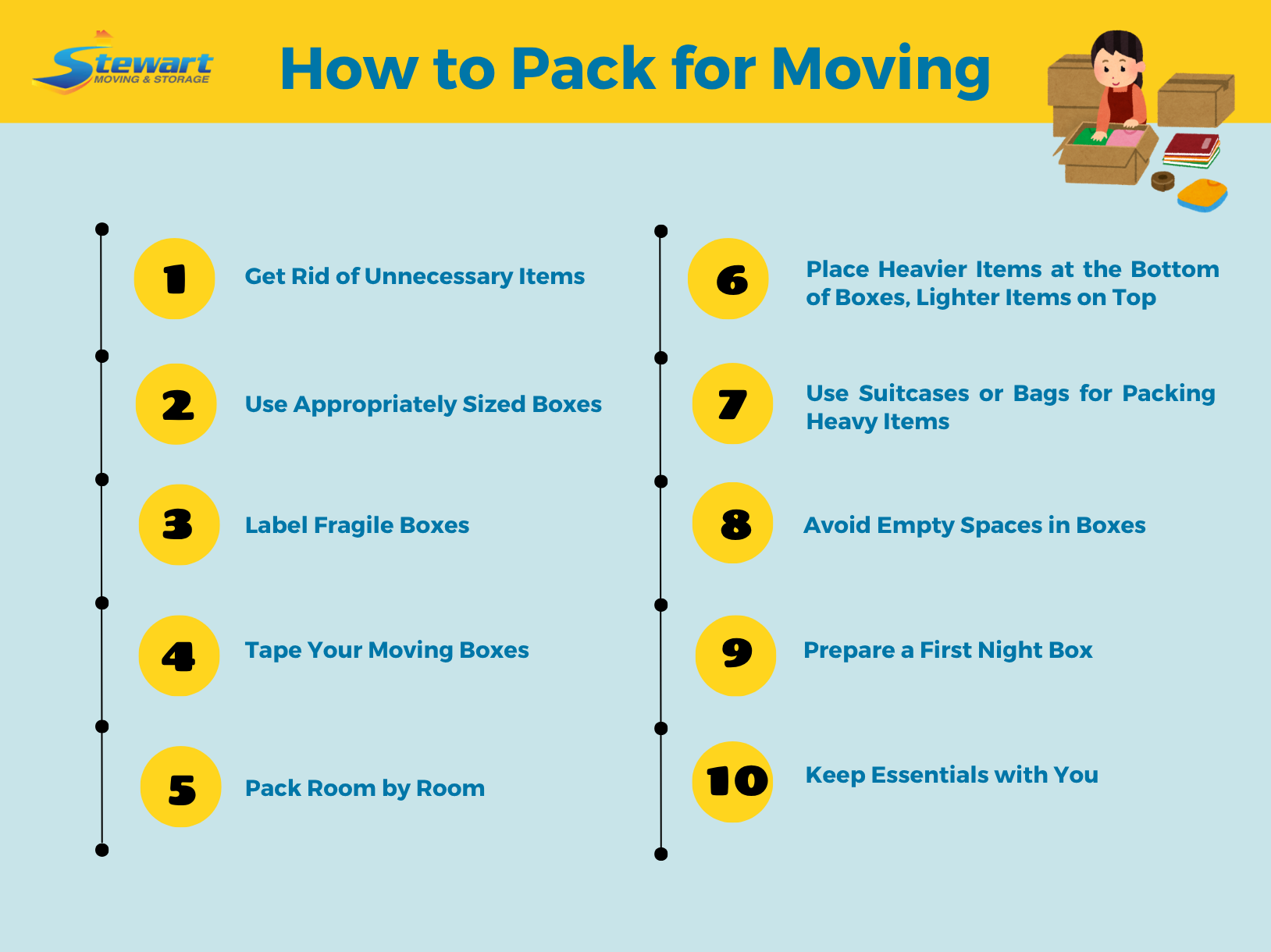
Fragile and Specific Items Packing Tips
Some items need extra TLC during your move. If you've got really valuable or sentimental items, it's worth getting professional packing help—trust us, it's cheaper than replacing a broken family heirloom. Always label fragile boxes clearly and make sure they go on the truck last so they come off first. At Stewart Moving & Storage, we’ve got your back when it comes to top packing and moving tips for your fragile and specific items.
Use Specialty Crates for Expensive Artwork
Protecting valuable and irreplaceable items like timeless art pieces, sculptures, or large mirrors requires more than standard boxes and packing paper. These items often necessitate specialty crating, a key piece of advice in moving company packing tips for high-value possessions. The custom crates you use can often be purchased or rented from your moving company or a specialized crating service. These crates are designed to provide a customized, secure fit that will protect the artwork from pressure, vibrations, and shocks that can occur during the moving process. They are typically constructed from wood and lined with padding materials like foam or ethafoam to cushion the item. Before crating, the artwork itself should be properly wrapped, often with acid-free paper and bubble wrap, paying special attention to corners and delicate surfaces. For particularly valuable pieces, consider consulting with art handling professionals. These specialized tips for packing and moving ensure your cherished artwork arrives at your new home in pristine condition.
Be Careful When Packing Kitchen Items
The kitchen is often considered one of the most challenging rooms to pack due to the sheer variety and fragility of its contents. Effective packing tips for moving your kitchen are essential. You should wrap each item individually. For plates and glassware, use plenty of packing paper or bubble wrap. A common moving company packing tips technique for plates is to wrap each one individually and then bundle 3-4 plates together, re-wrapping the bundle. Stand plates on their edges in the box, rather than flat, as they are stronger this way. Glasses should also be individually wrapped and packed with rims down, with crumpled paper inside and around them for cushioning. Pack items that are similar together in clearly labeled boxes (e.g., “KITCHEN - GLASSWARE - FRAGILE,” “KITCHEN - POTS & PANS”). Place heavier items like pots, pans, and small appliances at the bottom of the box, and lighter items like cutlery (wrapped to prevent injury), dish towels, or plasticware at the top. Ensure all sharp knives are securely wrapped in thick paper or cardboard and clearly marked, or placed in a knife block if possible. These packing tips and moving strategies will help ensure your kitchen arrives safely. You can learn more about how to pack plates for moving to keep fragile items secure.
Learn How to Pack a TV for Moving
Modern televisions, especially flat screens, are delicate and require specific packing to prevent damage. Learning how to pack a TV for moving correctly is essential. The process of packing a TV for moving begins with unplugging all cables and accessories. Carefully wind the electrical cords and other cables, fastening them with a twist tie or Velcro strap so they do not dangle or get tangled. It’s a good idea to place these cords and any remotes in a labeled plastic bag and tape it to the back of the TV or pack it in the same box. Use the original box and packaging if you still have it. If the original box is gone, you should purchase a special TV moving box. These are often adjustable and come with foam pieces or bubble wrap designed for TV protection. You can find these at moving supply stores or ask your moving company. Before placing the TV in the box, protect the screen from scratches and cracks by wrapping it with a soft blanket, a layer of bubble wrap, or a specialized foam screen protector. Ensure the TV is snug within the box and fill any voids with packing material to prevent movement. Clearly label the box “FRAGILE - TELEVISION - THIS SIDE UP” on all sides. For more details on how to safely pack your TV, we offer a step-by-step TV shipping guide.

Wrap Large or Valuable Furniture
Protecting your large or valuable furniture during a move is paramount, and proper wrapping is key. Before wrapping, disassemble any furniture pieces that can be taken apart, such as bed frames or table legs. Keep all hardware in a labeled plastic bag and tape it securely to the main furniture piece. Clean all surfaces to remove dust and debris. For wooden furniture, use furniture blankets or moving pads, ensuring all surfaces and corners are covered. Secure the blankets with packing tape (tape the blanket to itself, not directly to the furniture finish) or stretch wrap. Upholstered items like sofas and armchairs should also be protected with furniture blankets or plastic furniture covers to shield them from dirt, moisture, and tears. For valuable antiques or delicate pieces, consider professional crating or specialized wrapping techniques. Glass tabletops or mirrors should be removed, wrapped in bubble wrap, and then crated or packed in a flat box designed for such items. These packing tips and moving strategies for furniture will ensure your pieces arrive in the same condition they left.
Transport Frozen Goods Using a Cooler
Moving frozen or refrigerated food requires careful planning to prevent spoilage, especially during longer moves. The best approach is to try to consume as much of your frozen and refrigerated food as possible before moving day. However, if you need to transport some items, a good quality cooler and dry ice are your best friends. This is one of the tips for packing and moving perishable items. For frozen goods, dry ice is more effective than regular ice packs as it is colder and lasts longer. Remember to handle dry ice with gloves to prevent burns. Place the dry ice on top of the food items, as cold air sinks. Fill any empty spaces in the cooler with newspaper or towels to help maintain the temperature. Label the cooler clearly and try to transport it in your personal vehicle if possible, so you can monitor it. Some moving companies might advise against moving perishable items, especially on long-distance moves, so check with your mover about their policies.
Wrap Electronics in Bubble Wrap
Electronics are expensive and fragile, so they deserve extra protection during your move. Remove batteries from all devices before packing to prevent corrosion damage, and take photos of cord connections so you'll remember how to hook everything up later. Wrap each electronic item individually in bubble wrap, paying special attention to corners and screens. Use the original boxes if you still have them – manufacturers design these for maximum protection. If not, find boxes that are just slightly larger than your device and fill empty spaces with packing paper or foam to prevent shifting. Never pack electronics with heavy items, and always mark these boxes as "FRAGILE" and "THIS SIDE UP" to ensure careful handling.
Pack Clothes in Suitcases or Vacuum Seal Bags
Your clothes are some of the easiest items to pack, so take advantage of shortcuts that save you boxes and time. Rolling luggage is perfect for heavy items like jeans and sweaters—the wheels make transport a breeze. For bulky items like winter coats and comforters, vacuum seal bags are a game-changer, shrinking items to a fraction of their original size. Leave clothes on hangers and use wardrobe boxes for your nicest items, or simply drape them over the seats in your car for short moves. For everyday clothes, large trash bags work surprisingly well – just tie them loosely and label them clearly so they don’t get thrown out with the garbage!
Seal Liquids in Plastic Bags to Prevent Spills
Nothing ruins a move faster than a shampoo bottle leaking all over your other belongings. Before packing any liquids, remove the caps and place a piece of plastic wrap over the opening, then screw the cap back on tightly – this creates an extra seal. Put each bottle in its own ziplock bag, then group similar items together in larger plastic bags. For valuable or electronic items nearby, double-bag everything liquid just to be safe. Consider using up or donating half-empty bottles of cleaning supplies and toiletries before moving – they're cheap to replace and not worth the risk of spills. Pack all liquids upright in sturdy boxes and label them clearly so movers know to keep these boxes level during transport.
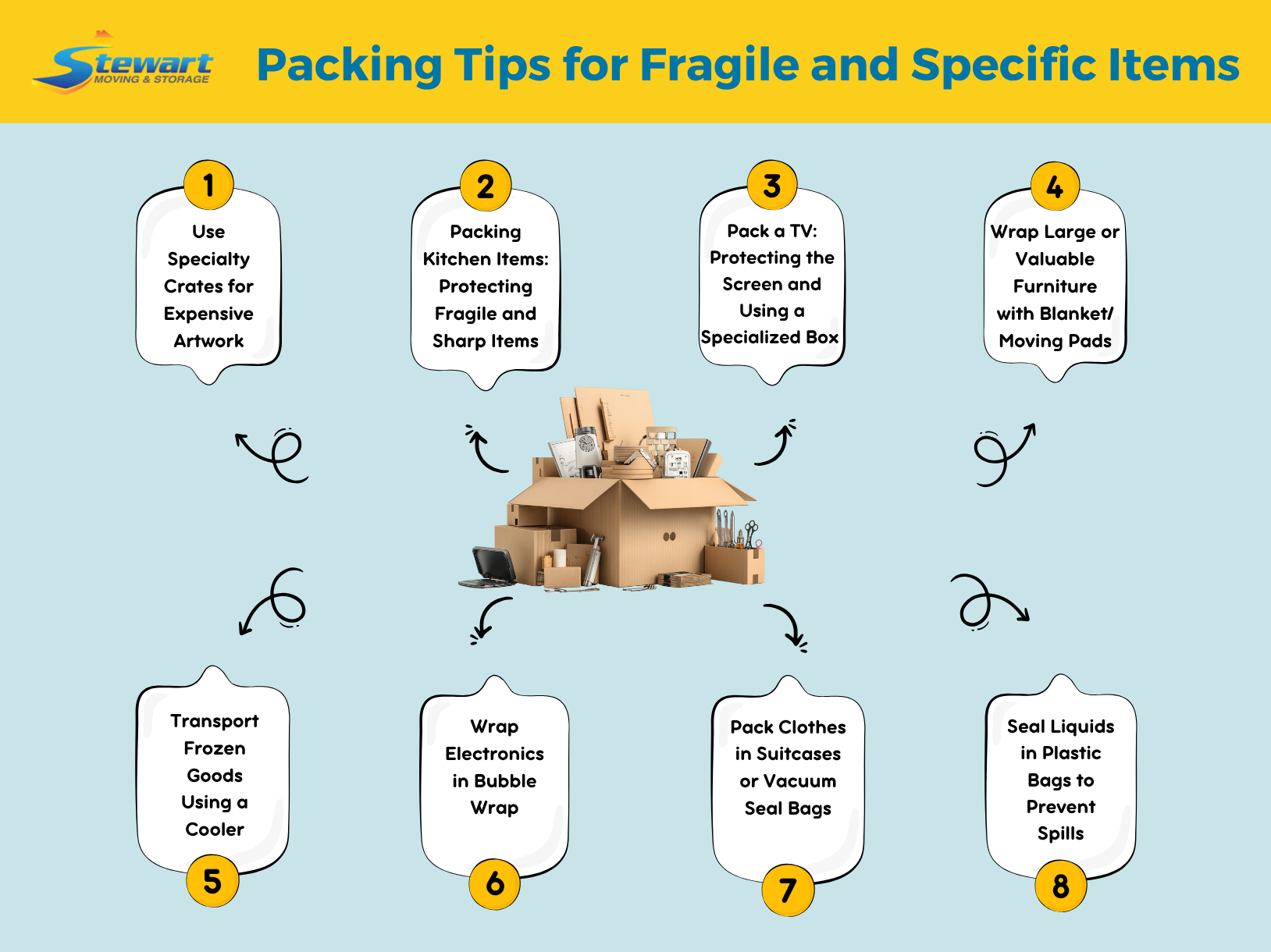
Top Packing and Moving Tips in Special Situations
Moving isn't one-size-fits-all, and certain situations call for extra planning and specialized approaches. Whether you're relocating with young kids who need routine and comfort, elderly family members who may find change overwhelming, or beloved pets who don't understand why their world is getting packed up, these circumstances require thoughtful preparation beyond standard packing tips. In the following sections, we'll cover practical tips for moving in these special situations so no family members (furry ones included!) get left behind in your planning process.
Packing Tips for Moving with Children and Pets
Moving can be particularly challenging for children and pets, who thrive on routine and familiarity. One of the most important moving tips in packing for families is open communication. Talk to your children about the move in advance, explaining what is happening and why, and answer their questions honestly. Reading age-appropriate books about moving can also help. Throughout the packing process and during the move itself, try to maintain their regular schedules for meals, naps, and bedtime as much as possible to provide a sense of normalcy. Prepare an essentials box specifically for your kids and pets. This should include their favorite toys, blankets, snacks, food, bowls, medications, and anything else that will make them feel comfortable and secure in the new, unfamiliar environment. On the actual moving day, the chaos can be overwhelming. If possible, arrange for a trusted friend or family member to look after your children and pets, or set up a quiet, safe room in your old or new home with familiar items where they can stay calm. When introducing pets to the new home, do it slowly. Keep cats in one room initially with their litter box, food, water, and familiar bedding. Walk dogs around the new neighborhood on a leash to help them acclimate. Involve children in setting up their new room; let them help unpack their belongings and decide where things go. This can give them a sense of ownership and excitement about the new space. Above all, be patient. It takes time for everyone, including children and pets, to adjust to a new home and environment. Provide extra comfort, reassurance, and attention during this transition period. These tips for packing and moving with kids and pets can help ease the stress of a move.
How to Pack for Moving with Seniors
Moving with elderly family members requires extra patience and consideration for their physical limitations and emotional attachment to belongings. Start the packing process earlier than usual, allowing plenty of time for sorting through decades of memories without rushing. Let seniors be involved in decision-making about their possessions – even if it takes longer. Pack a clearly labeled essentials box with medications, glasses, hearing aids, and comfort items they’ll want in the first 24 hours, like a coffee mug or blanket. Consider hiring professional packers for heavy lifting and physically demanding tasks, as this reduces stress on everyone involved. Create a familiar space in the new home first by unpacking the senior's bedroom and setting up their favorite chair or familiar decorations before tackling other rooms.
Moving & Packing Tips when Pregnant
Pregnancy adds unique challenges to an already stressful moving process, so prioritizing your health and energy is essential. Avoid heavy lifting entirely – this is the perfect time to delegate tasks to family, friends, or professional movers. Pack frequently needed items like prenatal vitamins, comfortable clothes, and doctor contact information in an easily accessible bag you'll keep with you. Schedule your move earlier in your pregnancy if possible, as the second trimester typically offers more energy than the exhausting first and third trimesters. Stay hydrated and take frequent breaks while supervising the packing process. Plan for extra rest time and don't feel guilty about asking for more help than usual – your body is already working overtime growing a baby.
Packing Tips when Moving Long-Distance or Cross-Country
Long-distance moves require more strategic planning since you won't have the luxury of making multiple trips. Create a detailed inventory list and take photos of valuable items for insurance purposes – this paperwork becomes crucial when your belongings are traveling hundreds or thousands of miles. Pack a survival suitcase with at least a week's worth of essentials, including clothes, toiletries, medications, and important documents, since your moving truck might arrive days after you do. Research your new area in advance and pack climate-appropriate clothing if you're moving to a different region. Use this opportunity to seriously declutter – the cost of moving unnecessary items across the country adds up quickly. Consider shipping some items separately, like books or non-fragile household goods, which can sometimes be cheaper than adding weight to your moving truck. Finally, plan your travel route and book accommodations early, especially if you're driving with pets or children who need reliable stops along the way.
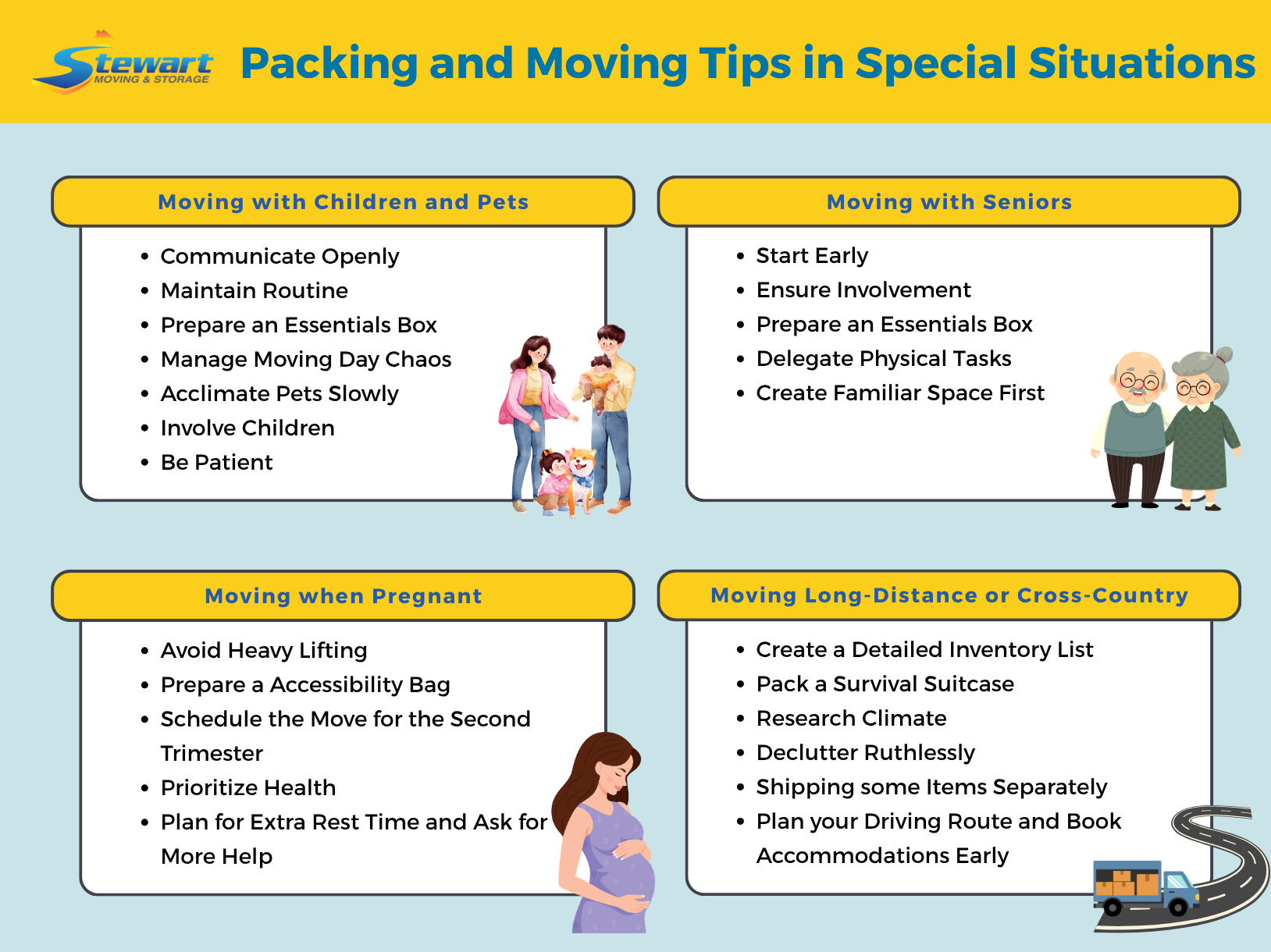
Post-Move Tips: Getting Settled Efficiently
Once the movers have left and you're surrounded by boxes, the next phase begins: settling into your new home. These post-move tips for packing and moving focus on making this process as efficient and stress-free as possible. Effective unpacking is just as important as effective packing. Having a plan can transform a daunting task into a manageable one. These moving tips and packing insights extend beyond just getting your items to the new location – they help you make it a home.
Set Deadlines for Unpacking
To avoid living amongst boxes for weeks or months, set realistic deadlines for unpacking. Start by prioritizing essential rooms like the kitchen, bedrooms, and bathrooms. Aim to unpack a certain number of boxes each day or dedicate specific time blocks to unpacking. Having a schedule and sticking to it can provide motivation and a sense of accomplishment. This approach to the unpacking stage helps maintain momentum.
Deal with Packing Supplies
As you unpack, you'll accumulate a mountain of empty boxes, packing paper, and bubble wrap. Dealing with these materials promptly is one of the best tips for packing and moving efficiently into your new home. Break down boxes as soon as they are empty to save space. Check with your local municipality about recycling options for cardboard and paper. Some moving companies offer box buy-back programs or pick-up services for used packing materials, which is a handy moving company packing tip if available. If your boxes are in good condition, consider offering them to others who are moving via online marketplaces or community groups.
> Learn more about our services:
- Movers in Fayetteville, NC | Stewart Moving & Storage
- Movers in Pensacola, FL | Best Local & Long Distance Moving Company
- Moving Services Richmond, VA | Best Local & Long Distance Moving
- Movers in Portsmouth, VA | Stewart Moving & Storage
- Movers in Jacksonville, FL | Best Local Moving Company
FAQs about Tips for Packing and Moving
Navigating a move can bring up many questions. Here are answers to some frequently asked questions, with valuable tips for packing and moving to guide you through the process. These moving tips and packing insights aim to address common concerns and provide actionable advice.
What are the simplest moving and packing tips?
The simplest moving tips focus on three basics: Start early, declutter ruthlessly, and label everything clearly. Begin packing non-essential items at least 4-6 weeks before your move, and get rid of anything you haven't used in the past year. Use a black marker to write the room destination and a brief description of contents on every box. Pack heavy items like books in small boxes, light items in large boxes, and always put heavier items at the bottom. Keep a "first day" box with essentials so you're not digging through dozens of boxes on your first night. This basic moving and packing tips checklist will save you time, money, and stress.
What are the best tips for moving for the first time?
First-time movers should focus on organization and realistic expectations – moving always takes longer than you think. Start by creating a moving binder or folder to keep all contracts, receipts, and important documents in one place. Get at least three quotes from different moving companies and read reviews carefully before deciding. Don't try to pack everything in one weekend; spread the work out over several weeks to avoid burnout. Ask friends and family for help, but also be prepared to feed them and provide plenty of drinks. Most importantly, expect the unexpected – something always goes wrong, whether it's a delayed truck or a box that won't fit through the door. Having a sense of humor and a backup plan will get you through your first move successfully. Remember, millions of people move every year, and you'll figure it out, too.
How far before a move should you start packing?
Ideally, you should start the moving process at least 4-6 weeks before your moving day. Begin with items you don’t use daily, such as out-of-season clothing, books, decorative items, and items in storage. This gradual approach prevents last-minute rushes and reduces stress. The more time you give yourself, the more organized and thorough you can be.
How to strategically pack for a move?
Strategic packing involve several key elements: declutter first, pack room by room, use appropriately sized boxes (heavy items in small boxes, light items in large boxes), label every box clearly with its contents and destination room, create an inventory list (especially for long-distance moves), and pack an essentials box for the first 24 hours in your new home. These tips for packing and moving ensure an organized and efficient process.
What is the hardest room to pack when moving?
Many people find the kitchen to be the hardest room to pack. This is because it contains a wide variety of items, many of which are fragile (dishes, glassware), awkwardly shaped (small appliances, pots and pans), or sharp (knives). Following specific packing tips for moving your kitchen items, such as wrapping everything individually and using dish pack boxes, is crucial.
How do you prepare for movers who are packing?
If you’ve hired movers for packing services, your preparation involves decluttering beforehand so they only pack what you intend to move. Clearly communicate any items you don’t want packed or items that require special handling. It’s also helpful to set aside personal essentials and valuables that you will transport yourself. Ensure there’s clear access and working space for the packers. These tips for packing and moving when using professional packers will streamline their work.
How do I maximize my packing for a move?
To maximize your packing efficiency: Use all available space within boxes without overstuffing, fill empty spaces with packing paper or soft items to prevent shifting, use luggage and bags for non-fragile items like clothing and books, and disassemble furniture where possible. Labeling correctly and creating an inventory are also key packing tips for moving that maximize organization. Think vertically when loading boxes and the truck.
What won't movers pack and move?
Most moving companies have a list of non-allowable items they won't pack or transport. These typically include hazardous materials (flammables, explosives, corrosives like paint, aerosols, ammunition, propane tanks), perishable foods, plants, and pets. Some movers may also refuse to move very high-value items like jewelry or important documents, advising you to transport them personally. Always confirm this with your movers.
How to pack for a move in 3 days?
Packing for a move in 3 days is challenging but possible if you're highly organized and ruthless. Focus on essentials first. Declutter as you go, but quickly – don’t overthink. Enlist as much help as possible from friends and family. Use plenty of boxes and don’t worry too much about perfect organization within them; focus on getting things safely packed. Label boxes by room. This accelerated packing tips moving approach requires intense focus.
What room should I pack first when moving?
Start packing rooms and items you use least. Good packing tips for moving suggest beginning with storage areas like attics, basements, and garages. Then move on to guest rooms, formal living/dining areas, and decorative items. Leave essential rooms like the kitchen, main bathroom, and primary bedroom for the last week. This approach minimizes disruption to your daily life.
Is it worth paying for packing when moving?
Whether paying for packing is worth it depends on your budget, time, and energy. Professional packing services, often highlighted in moving company packing tips, can save you a significant amount of time and reduce stress. Movers are experienced and can pack your belongings quickly and safely. If you're short on time, have a large home, or find packing overwhelming, the cost can be a worthwhile investment.
What is the best thing to pack first when moving?
The best things to pack first are items you rarely use. This includes out-of-season clothing, books you’re not currently reading, fine china or special occasion items, collectibles, and items stored in closets, attics, or basements. These priorities help you get a head start without impacting your daily routine.
How do I make moving and packing easier?
To make moving and packing easier, start early, declutter ruthlessly, create a detailed moving checklist and timeline, gather all necessary packing supplies in advance, pack room by room, label everything clearly, enlist help from friends or family or hire professional movers, and take care of yourself by staying hydrated and getting enough rest. Our comprehensive tips for packing and moving (above) cover the entire process. Following good moving company packing tips can simplify things.
How long does it take to pack a 3-bedroom house?
The time it takes to pack a 3-bedroom house can vary greatly depending on the amount of belongings, how much you declutter, and whether you have help. For one or two people packing, it could take anywhere from 3-7 full days of packing. If you spread it out over several weeks, it will be less intense. Professional packers might do it in 1-2 days. Always allow more time than you think you’ll need; this is one of the most practical packing tips for moving.
How to move in a hurry?
Moving in a hurry requires quick decision-making and efficiency. Prioritize tasks: Secure a moving truck or movers immediately, start packing essentials, and declutter rapidly. Don’t aim for perfection – aim for completion. Use professional packers if your budget allows, as they are fast. If DIY, get lots of help. Pack an “open first” box with everything you'll need immediately upon arrival. Forward your mail and arrange utilities. These tips for packing and moving quickly will help you manage a tight timeline.

